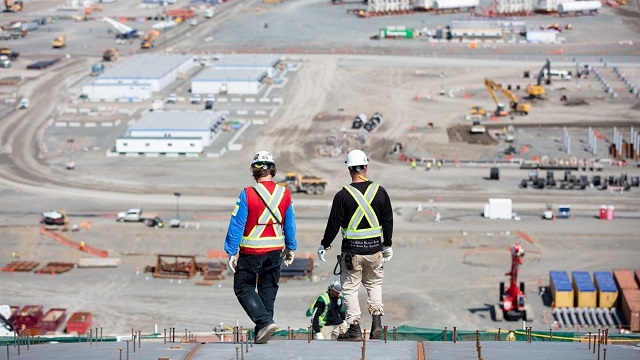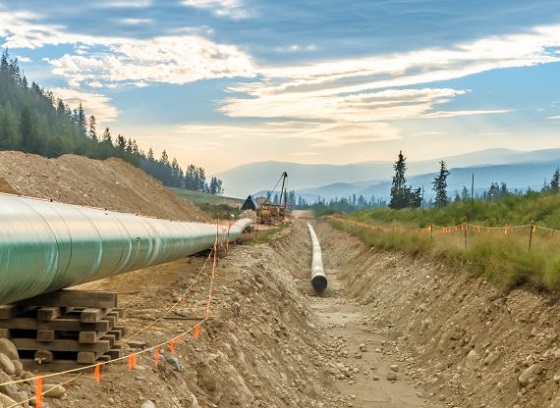Canadian Energy Centre
What’s next? With major projects wrapping up, what does Canada’s energy future hold

From the Canadian Energy Centre
By Mario Toneguzzi‘This is the first time Canada will enter the global marketplace as a global player, so it is an incredibly important change for the industry’
With the recent completions of the Trans Mountain expansion and Coastal GasLink pipelines, and the looming completion of LNG Canada within the next year, there are few major energy projects with the green light for one of the world’s largest and most responsible energy producers.
Which leaves a lingering question: In a world that has put a premium on energy security, what’s next for Canada?
Heather Exner-Pirot, a senior fellow and director of the natural resources, energy and environment program at the Macdonald-Laurier Institute, said Natural Resources Canada’s major projects inventory “has been in a pretty sharp decline since 2015, which is concerning.”
“It’s not just oil and gas but also mining, also electricity . . . It’s the overall context for investment in Canada,” said Exner-Pirot, who is also a special adviser to the Business Council of Canada.
“When we look at BC, we see TMX, Coastal GasLink, very soon LNG Canada will be finishing up. That’s probably in the order of $100 billion of investment that that province will lose.
“So you do start to think about what happens next. But there are some things on the horizon. I think that’s part of it. Other LNG projects where maybe it wasn’t politically popular, it wasn’t a social license, and maybe the labour force was also constrained, and now is opening opportunities.”
A recent analysis conducted by Exner-Pirot found that between 2015 and 2023, the number of energy and natural resource major projects completed in Canada dropped by 37 per cent. And those that managed to be completed often faced significant delays and cost overruns.
One notable project Exner-Pirot expects to fill the void is Ksi Lisims LNG, which is being developed on the northwest coast of Canada to export low-carbon LNG to markets in Asia. The project represents a unique alliance between the Nisga’a Nation, Rockies LNG and Western LNG.
Ksi Lisims LNG is a proposed floating LNG export facility located on a site owned by the Nisga’a Nation near the community of Gingolx in British Columbia.
The project will have capacity to produce 12 million tonnes of LNG per year, destined for markets in the Pacific basin, primarily in Asia where demand for cleaner fuels to replace coal continues to grow.
 Rendering of the proposed Ksi Lisims floating LNG project. Image courtesy Ksi Lisims LNG
Rendering of the proposed Ksi Lisims floating LNG project. Image courtesy Ksi Lisims LNG
As well, the second phase of the LNG Canada export terminal in Kitimat, B.C. shows increasing signs of moving forward, which would roughly double its annual production capacity from 14 million tonnes to 26 million tonnes, Exner-Pirot added.
While nearby, Cedar LNG, the world’s first Indigenous-owned LNG export facility, is closing in on the finish line with all permits in place and early construction underway. When completed, the facility will produce up to three million tonnes of LNG annually, which will be able to reach customers in Asia, and beyond.
According to the International Energy Agency, the world is on track to use more oil in 2024 than last year’s record-setting mark. Demand for both oil and natural gas is projected to see gradual growth through 2050, based on the most likely global scenario.
Kevin Birn, chief analyst for Canadian oil markets at S&P Global, said despite the Trans Mountain expansion increasing Canada’s oil export capacity by 590,000 barrels per day, conversations have already begun around the need for more infrastructure to export oil from western Canada.
“The Trans Mountain pipeline, although it’s critical and adds the single largest uplift in oil capacity in one swoop, we see production continue to grow, which puts pressures on that egress system,” he said.
 Photo courtesy Trans Mountain Corporation
Photo courtesy Trans Mountain Corporation
Birn said Canada remains a major global player on the supply side, being the world’s fourth-largest producer of oil and fifth-largest producer of natural gas.
“This is a really important period for Canada. These megaprojects, they’re generational. These are a once-in-a-generation kind of thing,” Birn said.
“For Canada’s entire history of being an oil and gas producer, it’s been almost solely reliant on one single export market, which is the United States. That’s been beneficial, but it’s also caused problems for Canada in that reliance from time to time.
“This is the first time Canada will enter the global marketplace as a global player, so it is an incredibly important change for the industry.”
Exner-Pirot said Canada has the ability to become a major exporter on the energy front globally, at a time when demand is accelerating.
“We have open water from B.C. to our allies in Asia . . . It’s a straight line from Canada to its allies. This is a tremendous advantage,” she said, noting the growth of data centres and AI is expected to see demand for reliable energy soar.
“We are seeing growing electricity demand after decades of plateauing because our fridges got more energy efficient and our washers and dryers got more energy efficient. Now we’re starting to see for the first time in a long time more electricity demand even in developed countries. These are all drivers.”
Alberta
Alberta’s huge oil sands reserves dwarf U.S. shale

From the Canadian Energy Centre
By Will Gibson
Oil sands could maintain current production rates for more than 140 years
Investor interest in Canadian oil producers, primarily in the Alberta oil sands, has picked up, and not only because of expanded export capacity from the Trans Mountain pipeline.
Enverus Intelligence Research says the real draw — and a major factor behind oil sands equities outperforming U.S. peers by about 40 per cent since January 2024 — is the resource Trans Mountain helps unlock.
Alberta’s oil sands contain 167 billion barrels of reserves, nearly four times the volume in the United States.
Today’s oil sands operators hold more than twice the available high-quality resources compared to U.S. shale producers, Enverus reports.
“It’s a huge number — 167 billion barrels — when Alberta only produces about three million barrels a day right now,” said Mike Verney, executive vice-president at McDaniel & Associates, which earlier this year updated the province’s oil and gas reserves on behalf of the Alberta Energy Regulator.
Already fourth in the world, the assessment found Alberta’s oil reserves increased by seven billion barrels.
Verney said the rise in reserves despite record production is in part a result of improved processes and technology.
“Oil sands companies can produce for decades at the same economic threshold as they do today. That’s a great place to be,” said Michael Berger, a senior analyst with Enverus.
BMO Capital Markets estimates that Alberta’s oil sands reserves could maintain current production rates for more than 140 years.
The long-term picture looks different south of the border.
The U.S. Energy Information Administration projects that American production will peak before 2030 and enter a long period of decline.
Having a lasting stable source of supply is important as world oil demand is expected to remain strong for decades to come.
This is particularly true in Asia, the target market for oil exports off Canada’s West Coast.
The International Energy Agency (IEA) projects oil demand in the Asia-Pacific region will go from 35 million barrels per day in 2024 to 41 million barrels per day in 2050.
The growing appeal of Alberta oil in Asian markets shows up not only in expanded Trans Mountain shipments, but also in Canadian crude being “re-exported” from U.S. Gulf Coast terminals.
According to RBN Energy, Asian buyers – primarily in China – are now the main non-U.S. buyers from Trans Mountain, while India dominates purchases of re-exports from the U.S. Gulf Coast. .
BMO said the oil sands offers advantages both in steady supply and lower overall environmental impacts.
“Not only is the resulting stability ideally suited to backfill anticipated declines in world oil supply, but the long-term physical footprint may also be meaningfully lower given large-scale concentrated emissions, high water recycling rates and low well declines,” BMO analysts said.
Alberta
The case for expanding Canada’s energy exports

From the Canadian Energy Centre
For Canada, the path to a stronger economy — and stronger global influence — runs through energy.
That’s the view of David Detomasi, a professor at the Smith School of Business at Queen’s University.
Detomasi, author of Profits and Power: Navigating the Politics and Geopolitics of Oil, argues that there is a moral case for developing Canada’s energy, both for Canadians and the world.
CEC: What does being an energy superpower mean to you?
DD: It means Canada is strong enough to affect the system as a whole by its choices.
There is something really valuable about Canada’s — and Alberta’s — way of producing carbon energy that goes beyond just the monetary rewards.
CEC: You talk about the moral case for developing Canada’s energy. What do you mean?
DD: I think the default assumption in public rhetoric is that the environmental movement is the only voice speaking for the moral betterment of the world. That needs to be challenged.
That public rhetoric is that the act of cultivating a powerful, effective economic engine is somehow wrong or bad, and that efforts to create wealth are somehow morally tainted.
I think that’s dead wrong. Economic growth is morally good, and we should foster it.
Economic growth generates money, and you can’t do anything you want to do in social expenditures without that engine.
Economic growth is critical to doing all the other things we want to do as Canadians, like having a publicly funded health care system or providing transfer payments to less well-off provinces.
Over the last 10 years, many people in Canada came to equate moral leadership with getting off of oil and gas as quickly as possible. I think that is a mistake, and far too narrow.
Instead, I think moral leadership means you play that game, you play it well, and you do it in our interest, in the Canadian way.
We need a solid base of economic prosperity in this country first, and then we can help others.
CEC: Why is it important to expand Canada’s energy trade?
DD: Canada is, and has always been, a trading nation, because we’ve got a lot of geography and not that many people.
If we don’t trade what we have with the outside world, we aren’t going to be able to develop economically, because we don’t have the internal size and capacity.
Historically, most of that trade has been with the United States. Geography and history mean it will always be our primary trade partner.
But the United States clearly can be an unreliable partner. Free and open trade matters more to Canada than it does to the U.S. Indeed, a big chunk of the American people is skeptical of participating in a global trading system.
As the United States perhaps withdraws from the international trading and investment system, there’s room for Canada to reinforce it in places where we can use our resource advantages to build new, stronger relationships.
One of these is Europe, which still imports a lot of gas. We can also build positive relationships with the enormous emerging markets of China and India, both of whom want and will need enormous supplies of energy for many decades.
I would like to be able to offer partners the alternative option of buying Canadian energy so that they are less reliant on, say, Iranian or Russian energy.
Canada can also maybe eventually help the two billion people in the world currently without energy access.
CEC: What benefits could Canadians gain by becoming an energy superpower?
DD: The first and primary responsibility of our federal government is to look after Canada. At the end of the day, the goal is to improve Canada’s welfare and enhance its sovereignty.
More carbon energy development helps Canada. We have massive debt, an investment crisis and productivity problems that we’ve been talking about forever. Economic and job growth are weak.
Solving these will require profitable and productive industries. We don’t have so many economic strengths in this country that we can voluntarily ignore or constrain one of our biggest industries.
The economic benefits pay for things that make you stronger as a country.
They make you more resilient on the social welfare front and make increasing defence expenditures, which we sorely need, more affordable. It allows us to manage the debt that we’re running up, and supports deals for Canada’s Indigenous peoples.
CEC: Are there specific projects that you advocate for to make Canada an energy superpower?
DD: Canada’s energy needs egress, and getting it out to places other than the United States. That means more transport and port facilities to Canada’s coasts.
We also need domestic energy transport networks. People don’t know this, but a big chunk of Ontario’s oil supply runs through Michigan, posing a latent security risk to Ontario’s energy security.
We need to change the perception that pipelines are evil. There’s a spiderweb of them across the globe, and more are being built.
Building pipelines here, with Canadian technology and know-how, builds our competitiveness and enhances our sovereignty.
Economic growth enhances sovereignty and provides the resources to do other things. We should applaud and encourage it, and the carbon energy sector can lead the way.
-

 International2 days ago
International2 days agoOttawa is still dodging the China interference threat
-

 Business2 days ago
Business2 days agoTaxing food is like slapping a surcharge on hunger. It needs to end
-

 Business23 hours ago
Business23 hours agoThere’s No Bias at CBC News, You Say? Well, OK…
-

 COVID-192 days ago
COVID-192 days agoJudge denies Canadian gov’t request to take away Freedom Convoy leader’s truck
-

 espionage2 days ago
espionage2 days agoCarney Floor Crossing Raises Counterintelligence Questions aimed at China, Former Senior Mountie Argues
-

 Energy2 days ago
Energy2 days ago75 per cent of Canadians support the construction of new pipelines to the East Coast and British Columbia
-

 Health1 day ago
Health1 day agoFDA warns ‘breast binder’ manufacturers to stop marketing to gender-confused girls
-

 International1 day ago
International1 day ago2025: The Year The Narrative Changed










